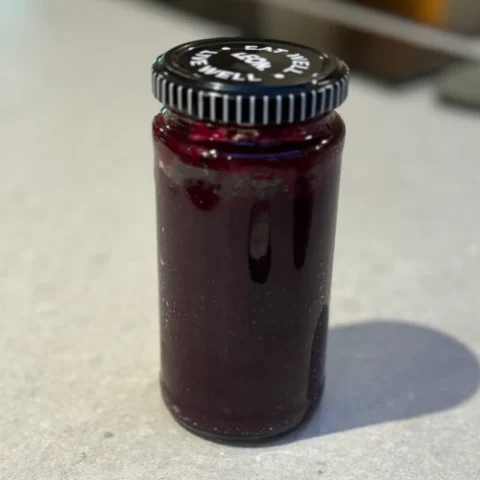
Delicious Beetroot Ketchup Recipe | Healthy & Naturally Sweet
Discover a naturally sweet and vibrant Beetroot Ketchup Recipe that replaces tomatoes with earthy, nutrient-rich beetroot. This healthy, homemade twist on the classic condiment brings colour, depth, and antioxidants to your table—perfect for chips, veggie burgers, and everything in between.
Ingredients
- 500g (3 cups) cubbed, cooked red beetroot
- 120ml (½ cup) white wine vinegar
- 240ml (1 cup) water
- 5 tbsp organic unrefined caster (superfine) sugar
- 1 bay leaf
- 2 shallots, finely chopped
- Pinch sea salt and cracked black pepper
Instructions
- Heat all the ingredients in a heavy-based saucepan over medium heat and allow to simmer for around 10 minutes, or until the shallots are cooked and the liquid has slightly thickened.
- Remove from the heat and let the mixture cool slightly before removing the bay leaf. Then tip into a blender and blend until super-smooth. It should be bright pink and have a glossy ketchup-like appearance.
- Carefully pour into sterilised jars or containers and pop them in the fridge to cool.
- Serve and use like ketchup for no longer than three weeks.
Nutrition Information:
Yield: 10 Serving Size: 1Amount Per Serving: Calories: 55Total Fat: 0gSaturated Fat: 0gUnsaturated Fat: 0gSodium: 54mgCarbohydrates: 13gFiber: 1gSugar: 11gProtein: 1g
From Classic Condiments to Plant Power: The Story Behind Beetroot Ketchup
Ketchup. A word that instantly brings to mind the deep red, tangy-sweet sauce we love to dollop on chips or drizzle over veggie burgers. But here’s a surprise: the earliest versions of ketchup contained no tomatoes at all. Instead, they were fermented fish sauces from 17th-century China, known as kê-tsiap. It wasn’t until the 19th century that the tomato-based version took over the Western world, thanks to industrialisation and clever marketing.
Today, as we rethink the ingredients on our plates, a new star is emerging—the Beetroot Ketchup Recipe. A naturally sweet, earthy alternative that brings a whole new dimension to the classic sauce.
A Splash of Colour and History
Beetroot has a fascinating history of its own. Cultivated since ancient times along the Mediterranean, it was prized first for its leaves before people discovered the sweet, crimson root beneath. By the 16th century, beets were making their way into European kitchens, loved for their rich colour and nutritional value.
Using beetroot as the main base for ketchup isn’t just a clever plant-based twist—it’s a return to the condiment’s creative roots. Before tomatoes became the standard, ketchups were made from mushrooms, plums, walnuts, and even oysters. So, in a way, Beetroot Ketchup isn’t breaking the rules—it’s reviving tradition with a modern, healthy edge.
Why Choose Beetroot Over Tomatoes?
At first glance, tomatoes might seem irreplaceable in ketchup. They’re tangy, juicy, and perfectly red. But beetroot brings something even more interesting to the table:
- Natural Sweetness – Beetroots are naturally sweet, which means less added sugar in your ketchup. That makes your sauce not only tastier but also better for blood sugar balance.
- Nutrient Density – Beetroot is packed with folate, manganese, potassium, and dietary fibre. It’s also rich in betalains, powerful antioxidants that give it its vibrant colour and help reduce inflammation.
- Earthy Depth – The flavour of beetroot adds a subtle earthiness and richness that elevates any dish, especially roasted vegetables or plant-based burgers.
- No Acid Reflux – For those sensitive to tomato acidity, beetroot offers a gentle, stomach-friendly alternative.
So next time you’re reaching for a bottle of tomato ketchup, think beet—it’s naturally sweet, nutrient-packed, and adds a unique twist to your plate.
Fun Facts About Ketchup and Beets
- The world consumes over 800 million bottles of ketchup every year—enough to fill an Olympic-sized swimming pool!
- Beetroots were once used as a natural dye for clothes and even hair during the 18th century.
- Heinz, the global ketchup giant, once made walnut ketchup before switching to tomatoes.
- Ancient Romans considered beetroot an aphrodisiac—and modern science backs it up, since beets boost nitric oxide levels, improving circulation!
Nutritional Boost from Beetroot Ketchup
Each spoonful of Beetroot Ketchup delivers a colourful dose of nutrition. It’s low in fat and calories but high in fibre and plant-based compounds that support heart health and detoxification. Beetroots are especially rich in nitrates, which can enhance athletic performance by improving oxygen delivery—something endurance athletes might appreciate after a long run or ride.
It’s also worth noting that while commercial tomato ketchup often contains hidden sugars and preservatives, homemade beetroot ketchup keeps things natural, fresh, and full of flavour.
Serving Ideas and Pairings
This Beetroot Ketchup Recipe is as versatile as it is beautiful. Use it anywhere you’d use regular ketchup—over oven-baked chips, crispy tofu, vegan burgers, or even as a dipping sauce for roasted sweet potatoes. Its rich, velvety texture and jewel-like colour make it as visually striking as it is delicious.
For a full plant-based meal pairing, try serving it with:
- Vegan Mushroom Burgers
- Vegan Roast Potatoes
- Homemade Veggie Nuggets
And if you’re curious about beetroot nutrition, check out the British Nutrition Foundation’s guide on beetroot benefits.
Final Thoughts: A Healthier Take on a Global Classic
This Beetroot Ketchup Recipe isn’t just about swapping ingredients—it’s about rediscovering the creativity and history behind one of the world’s favourite condiments. By replacing tomatoes with beets, you’re not only cutting back on sugar and acidity but adding vibrant colour, antioxidants, and flavour depth to your meals.
Healthy, natural, and rooted in tradition—this is ketchup reimagined for the modern, plant-powered kitchen.



